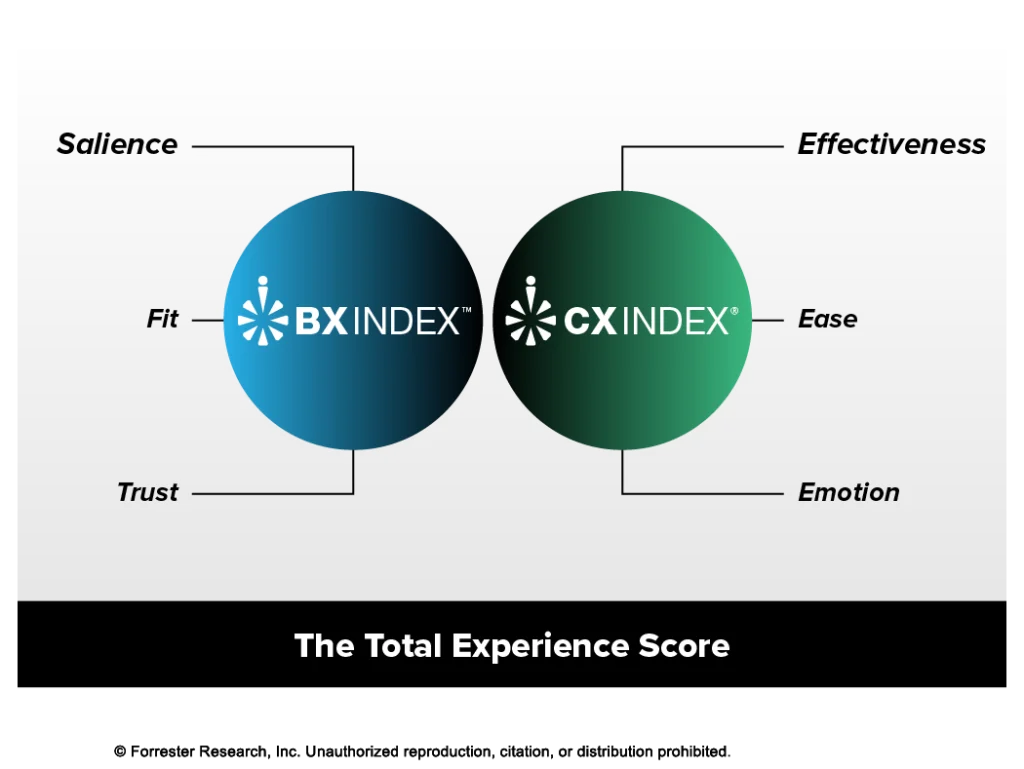Forrester’s Total Experience Score combines our Brand Experience Index (BX Index™) and Customer Experience Index (CX Index™) to measure how well a brand wins and serves customers throughout the customer lifecycle.
The BX Index, calculated for both noncustomers and customers who are aware of a brand in a specific industry, measures how successfully a company builds brand perceptions that attract new customers and retain them. In contrast, the CX Index focuses exclusively on customers who have interacted with the brand within the past 12 months and measures how successfully a company delivers customer experiences that create and sustain loyalty.
Together, these two scores form the Total Experience Score. Half of the Total Experience Score is calculated from the noncustomer BX Index score, and the other half is calculated from a combination of customer BX Index and CX Index scores.
Forrester covers more than 400 brands across 10 industries in 13 countries. Forrester maintains control over all brand, industry, and market decisions. Companies cannot pay to be included or excluded from our annual benchmark survey, nor can they purchase favorable scores or ranking results. Forrester independently acquires a nationally representative sample in each market and does not use customer lists supplied by any company included in our annual benchmark survey.

The BX Index Process
Forrester’s BX Index is new for 2025. We created it by combining our Brand Energy Index with our trust data. The BX Index contains the three most important elements of brand perception — salience, fit, and trust — and links them with the outcome metrics of future purchasing, purchase preference, price premium, and advocacy. The influence the brand perception metrics have on the outcome metrics are weighted by industry and by whether a survey respondent is a customer or noncustomer.
Noncustomer respondents in the BX Index state that they are aware of the products or services of a brand but are not customers. Customers self-identify as a current user of the products or services of the brand — and have interacted with it in the last 12 months. If respondents qualify for multiple brands within an industry, they are randomly assigned to only one brand in that industry. Both customer and noncustomer respondents are asked about their perceptions of the respectively assigned brand. The customer and noncustomer BX Index algorithm is applied to each respondent’s answers to calculate the customer or noncustomer score. A brand’s noncustomer BX Index score is the average of all individual scores for noncustomers of that brand. The same applies to customers. A brand’s overall BX Index score is the average of all customer and noncustomer scores calculated for the respondents who answered for that brand.
The CX Index Process
The current CX Index methodology has been used for more than 10 years. The CX Index survey measures CX quality, customer loyalty, CX driver performance, and several other factors about the experience and the customer. The CX Index algorithm models the relationship between CX quality and customer loyalty. Because loyalty dynamics vary by industry, the CX quality metrics are weighted in the algorithm based on how much impact they have on loyalty in each industry per market.
CX Index survey respondents self-identify as a current customer who has directly interacted with selected brands in the past 12 months. If respondents qualify for multiple brands within an industry, they are randomly assigned to only one brand within that industry. Respondents are asked questions about the experiences they have had with an assigned brand. The CX Index algorithm is applied to each respondent’s answers to calculate a CX Index score. A company’s CX Index score is the average of CX Index scores given to the brand by each of its customers in the survey sample.